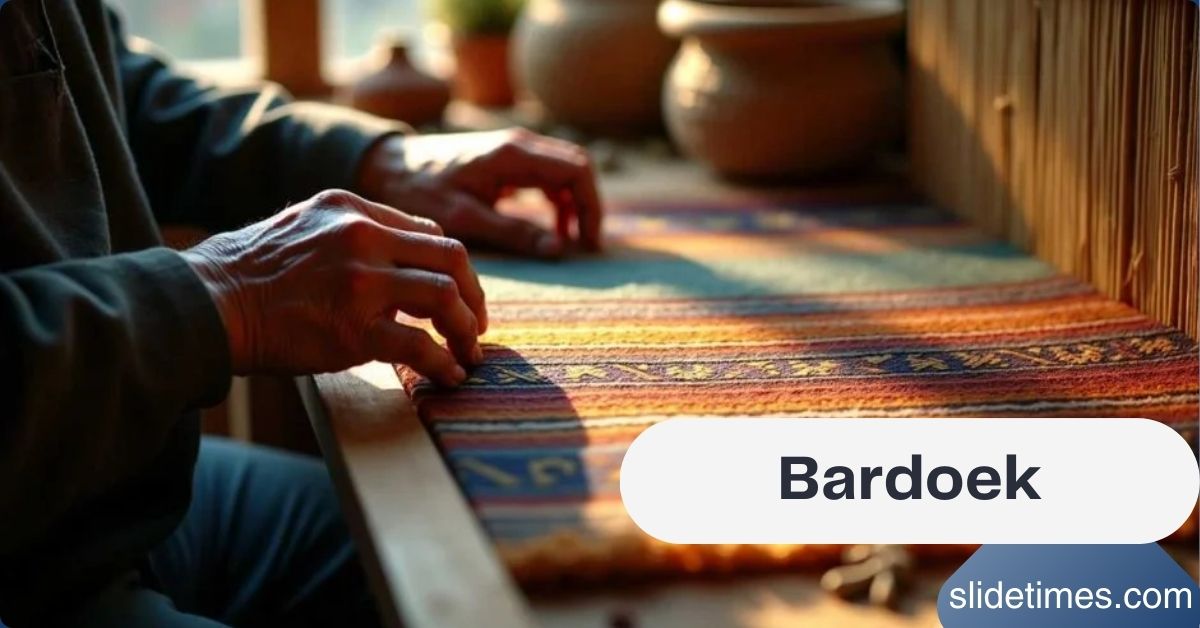The word bardoek may sound unusual to many readers in the United States, but its meaning runs deeper than just a label for a fabric or craft. At its core, bardoek is not simply a textile or an object; it represents a cultural expression, a centuries-old tradition, and a medium through which stories are told and identities are preserved. When exploring bardoek, one is not only looking at a piece of cloth but at history, artistry, and heritage woven into its very threads.
For generations, artisans have passed down the skills required to make bardoek. The colors, patterns, and textures are not chosen randomly; they hold significance tied to community, geography, and even personal milestones. Today, as global interest in authentic and sustainable products grows, bardoek has become a fascinating point of discussion for those interested in craftsmanship, culture, and ethical production.
The Origins of Bardoek
Understanding bardoek begins with tracing its cultural and historical roots. While modern interpretations vary, historical accounts suggest that bardoek was often created within specific communities as a way to preserve identity and heritage. In these communities, fabric was never a mere necessity. It was a symbol, carrying messages through its patterns and reflecting pride in craftsmanship.
The making of bardoek was traditionally labor-intensive, requiring not only technical expertise but also an eye for design. Families often considered the art form a generational responsibility, ensuring that younger members learned the methods of weaving, dyeing, or handcrafting. In this way, bardoek became more than an object—it became a living legacy.

The Cultural Meaning of Bardoek
Unlike mass-produced materials, bardoek is often tied to rituals, ceremonies, or important life events. For example, specific pieces might be worn during weddings, passed down as heirlooms, or exchanged as gifts to mark respect and honor. Each detail—the texture, the colors, the geometric designs—can symbolize values such as unity, prosperity, or resilience.
Also Read: Wiredin_en.pdf: The Essential Resource for IT Professionals and Digital Transformation
In a broader sense, bardoek highlights the intersection of culture and art. It demonstrates how communities communicate identity and shared values without words, relying instead on fabric as a storytelling tool. To outsiders, it may look like a decorative textile, but to those within the tradition, bardoek carries meaning that goes beyond the surface.
Bardoek as a Craft of Patience and Skill
The craftsmanship behind bardoek requires an extraordinary blend of patience and technical skill. Unlike modern factory-made cloth, bardoek is often handmade, with artisans carefully overseeing every stage of the process. This begins with sourcing the right raw materials, preparing them for weaving or dyeing, and finally applying intricate designs that transform the fabric into something exceptional.
What makes bardoek unique is not only the techniques but the artistry of interpretation. No two pieces are exactly alike because each artisan brings personal creativity, intuition, and storytelling into the work. For many, the imperfections of handmade bardoek are not flaws but marks of authenticity—proof that a human hand, rather than a machine, shaped the fabric.
Modern Uses of Bardoek
In today’s world, bardoek continues to find relevance beyond its traditional settings. While its ceremonial and cultural significance remains strong, designers and collectors have also begun reinterpreting it for contemporary purposes. Fashion brands may use bardoek in clothing lines, while interior decorators may highlight it in modern homes as wall art, upholstery, or statement pieces.
This revival does more than make bardoek trendy. It helps keep traditional skills alive by creating a market for them. Younger artisans, who might otherwise move away from traditional crafts, are inspired to preserve their heritage while adapting designs for new generations. This balance of preservation and innovation ensures that bardoek will continue to remain meaningful in the future.
Bardoek and Sustainability
One of the most remarkable aspects of bardoek is its connection to sustainability. Unlike fast fashion or industrial fabrics, bardoek often relies on natural fibers and dyes, with processes that minimize waste and environmental harm. For consumers in the US and worldwide, this aligns with the growing demand for eco-friendly and ethically produced materials.
Also Read: GoMyFinance.com Bills: A Comprehensive Guide
When you buy or support bardoek, you are not only acquiring a beautiful piece of art but also investing in an eco-conscious system. You are helping artisans maintain traditional practices that respect the earth, while also promoting fair wages and long-term sustainability.
The Role of Bardoek in Global Culture
Globalization has brought bardoek to audiences far beyond its original communities. Collectors, scholars, and fashion designers from around the world now recognize its value. Exhibitions often display bardoek as both an art form and an ethnographic treasure, giving viewers a chance to appreciate the craftsmanship while learning about its cultural context.
This global recognition has also sparked conversations about authenticity and appropriation. To ensure respect for the communities that create bardoek, many advocates emphasize the importance of sourcing directly from artisans or cooperatives. By doing so, buyers not only honor the craft but also support its rightful custodians.
Bardoek in Everyday Life
Although it holds deep cultural weight, bardoek is not only for ceremonial or artistic use. Many families integrate bardoek into their daily lives—using it as clothing, decoration, or practical household fabric. This everyday functionality is what makes bardoek so special: it blends the extraordinary with the ordinary, proving that art can be part of life rather than separate from it.
In modern American homes, bardoek can serve a similar role. Whether as a table runner, a framed wall hanging, or a custom piece of clothing, incorporating bardoek into daily routines adds beauty while connecting one to a rich cultural tradition.
Preserving the Legacy of Bardoek
The greatest challenge facing bardoek today is preservation. As mass-produced goods dominate markets, traditional crafts face the risk of fading away. However, through education, exhibitions, and online platforms, communities and supporters are working hard to protect this heritage.
Schools and workshops often teach younger generations the value of bardoek, not only as a skill but as a part of cultural identity. Likewise, international consumers can play a role by choosing authentic bardoek products and sharing their stories with wider audiences. In this way, bardoek becomes a bridge between past and future, between local and global.
Also Read: Luxiamtln: Everything You Need to Know
Frequently Asked Questions About Bardoek
What exactly is bardoek?
Bardoek is a traditional craft and material that represents culture, artistry, and history. It is usually handmade, featuring unique patterns, colors, and textures that hold symbolic meaning.
Why is bardoek considered special?
It is special because it is not just a textile but a cultural expression. Each piece of bardoek often tells a story, represents values, or marks important events.
Can bardoek be used in modern homes?
Yes, bardoek fits beautifully in contemporary spaces. It can be used as décor, upholstery, or fashion pieces, adding both style and cultural depth.
Is bardoek sustainable?
Yes, many forms of bardoek use natural fibers and dyes, and the production process is eco-friendly compared to mass-produced fabrics.
How can I make sure I buy authentic bardoek?
To ensure authenticity, buy directly from artisans, cooperatives, or reputable organizations that support traditional crafts and fair trade.
Is bardoek the same everywhere?
No, different communities have their own variations of bardoek, each with distinct styles, colors, and meanings.
How long does it take to make bardoek?
The process can take weeks or even months, depending on the complexity of the design and the size of the piece.
Why is bardoek important for cultural identity?
Because it carries traditions, stories, and values, bardoek helps communities preserve their identity across generations.
Conclusion
Bardoek is more than a material—it is a cultural legacy, a statement of craftsmanship, and a reflection of sustainable practices. From its traditional origins to its modern adaptations, bardoek bridges history and the present. For US readers, engaging with bardoek offers a chance to appreciate not only the artistry of other cultures but also the shared human desire to express meaning through creation.
By supporting bardoek, whether as a consumer, collector, or admirer, one contributes to keeping this living tradition alive. It is proof that even in a fast-moving world, patience, artistry, and cultural pride still hold timeless value.
